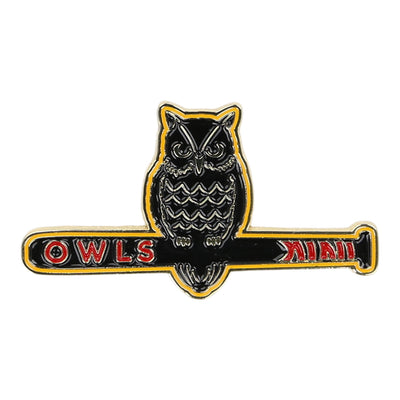Five Of Our Favorite Hall of Famers
Anyone who has ever been to Cooperstown on Hall of Fame Weekend each summer knows what a special place it is. Thousands crowd Main Street to celebrate our great game and honor the latest inductees to the Hall of Fame.
Ebbets has been supplying the flannel induction jerseys for the ceremonies for years, and now we are thrilled to announce a new upcoming partnership with the Hall allowing us to make those jerseys available to you. They will be available for sale online on Tuesday, October 24, 2023. We thought it would be fun to spotlight a few of our favorite inductees.
A Little History
The National Baseball Hall of Fame and Museum was established by Peter Clark, heir to the Singer Sewing Machine Company, in 1939. The year was chosen as baseball’s “official” centennial to commemorate the mythical laying down of the first baseball diamond in a cow pasture in Cooperstown, NY by Abner Doubleday in 1839. The historical veracity of this claim, and the story of baseball’s origins are a tale for another day. Here are five of our own favorite Hall of Fame inductees.

Babe Ruth, Inducted 1939
What has not been said about the Sultan of Swat? Star Red Sox pitcher for several seasons before being sold to the Yankees and single handedly revolutionizing the game, both with his bat and his larger-than-life personality. Historians and fans debate whether he was the game’s greatest all-time player. In addition to his power at the plate, he was a top-tier pitcher early in his career. Ruth didn't only have power, he hit for average (lifetime .342!), and covered his position well in the outfield. During his prime he was the world’s biggest celebrity, with every hot streak, slump, and off-field activity covered by a press that could not get enough. Babe Ruth accomplished every achievement in baseball he could ever dream of save one: He was never given the opportunity to manage a big-league club.
Lou Gehrig, Inducted 1939
It is perhaps unfortunate that Lou Gehrig’s iconic “Luckiest Man” speech at the end of his career has come to overshadow his actual accomplishments as a player. Gehrig and Ruth were the one-two offensive punch of the Yankees during their glory years in the 1920s and 30s (the original Yankee numbering scheme went by batting order, hence Ruth’s #3 and Gehrig’s #4). Among the Yankee first baseman’s many achievements: he was an All Star seven consecutive times, won the Triple Crown in 1934, won the AL home run crown three times, and hit four home runs in one game in 1932. Gehrig was voted All-Time First Baseman in 1969. He was elected to the Hall in a special vote in 1939.

Jackie Robinson, Inducted 1962
If all Jackie Robinson had done in his career was push his way through the door of segregated major league baseball with grace, dignity, and ferocious competitiveness, he would be worthy of induction. Jackie had not only his personal challenges to deal with, but he also carried the hopes and dreams of all Black Americans with him onto the field every day. His answer to the many skeptics who thought he would fail once in a big league uniform? The National League’s first Rookie of the Year award (1947), MVP (1949), two-time stolen base leader, and batting champion (1949). He also led his team to six World Series appearances. Before even putting on a Dodgers uniform, he was a star multi-sport athlete at UCLA, was an Army officer, played professional football and semi-pro basketball, and was a teammate of Satchel Paige of the Kansas City Monarchs of the Negro American League. After his retirement from baseball, he was a business executive, a banker, and a civil rights leader.
Satchel Paige, Inducted 1971
Joe DiMaggio said he was the best pitcher he ever faced. No one knows exactly how many teams he played for in his career, for how many years, or even his real age. But Leroy “Satchel” Paige was to Black Baseball what Babe Ruth was to white baseball, with a larger-than-life personality and the pitching skills to back it up. When the press would speculate about who would be the first Black player in the bigs, it was Paige’s name that came up most often. On teams from East to West, to Canada, the Dominican Republic, Mexico, and Puerto Rico, Paige built a reputation for fast living, quotable quips, and most of all, ferocious pitching skills. When the call came from Cleveland owner Bill Veeck in 1948, Paige became the oldest “rookie” in MLB history at 42. Satch’s pitching style – honed over decades in the Negro Leagues – was a surprise to American League hitters. When AL president outlawed his “hesitation” pitch, Paige said “I guess Mr. Harridge did not want me to show up those boys who were young enough to be my sons." Because the Hall of Fame did not initially recognize the records and achievements of Black ballplayers before 1947, a special committee was set up to induct the greatest from the Negro Leagues era. Paige was the first of his peers inducted.

Roberto Clemente, Inducted 1973
Roberto Clemente was offered a contract to play professional ball by the Santurce Cangrejeros in 1952 when he was only eighteen. The Brooklyn Dodgers signed him soon after and assigned him to their Montreal farm club, where the Spanish-speaking Clemente had to contend with not just one, but two new languages, English and French. Drafted by the Pirates in 1954, he would never play with another major league team. Early attempts to Americanize him included calling him “Bob Clemente” on his baseball card. Clemente was a hero in Puerto Rico and would both play and manage in the Puerto Rico winter league in the off-season. Roberto’s seasons with Pittsburgh included two World Series appearances in 1960 and 1971, when he was the Series MVP. His career came to a tragic end on the last day of 1972 when the plane delivering earthquake aid to Nicaragua crashed with Clemente on board. The Hall of Fame voted to waive the waiting requirement and inducted him in 1973 with 92% of the vote. Among Clemente’s on-field accomplishments: 3000 hits, 12 Gold Glove awards, and baseball’s only walk-off inside the park grand slam home run.











